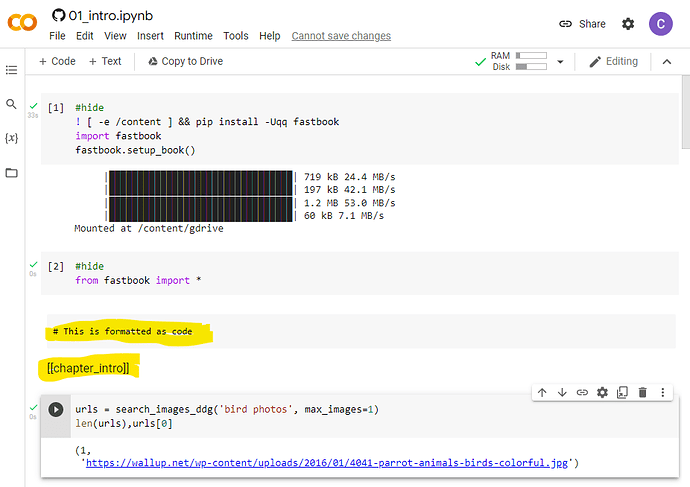Has anybody else found that Jupyter’s tab complete and shift + tab don’t work for them in the Fast.ai box on Gradient?
By default Gradient uses their own jupyter IDE where nothing quite works the same, unfortunately. However on the left-hand icon bar, at the bottom, there’s a button which switches over to genuine JupyterLab. If you click that, it should all work fine.
You did everything correctly (see the green ticks and run time next to each cell). I could run search_images_ddg afterwards. That means the import was successful.
The statement Unsupported Cell Type. Double-Click to inspect/edit the content. is a separate cell NOT an error message!!! If you double click it, you will see the content as highlighted. Since the fastbook is written in Juypter Notebook, the cell may not be compatible with Google Colab.
@Jeremy please consider mentioning this incident in the next lesson.
Quick question on following the book using the Paperspace. As you can see in the screenshot below I came across a handful of placeholders (<>) in the text but they seem empty.
- Is there something I need to do to get these placeholders filled, please?
- Also, I am not sure where/how I should find the clean version of the code. Is there any instructions on how to import the clean to Paperspace, please? the book refers to them but I am a bit lost on that.
When you click on that cell to put it in edit mode, you’ll see there’s actually an id in there, which matches to ids used for chapters, figures, etc elsewhere in the book. It’s used for creating cross-references in the paper book, but isn’t supported by Jupyter, so it’s blank.
Hi,
I attempted running the course notebooks on my laptop. For this I conda installed fastai with python 3.7. Further i also conda installed fastbook. However I am not able to run the notebooks an get the error:
ModuleNotFoundError: No module named 'torch''
Doesn’t fastai module install pytorch as well?
In pip it install pytorch along with fastai module. In conda also that should be the case
try following in colab:
from google.colab import drive
drive.mount("/content/gdrive")
Then it should open a new page to ask for login to ur google account
If I just pip install fastbook will it automatically install fastai as well?
It worked with pip. Cond seems to hav an issue
Yes it will install fastai as well.
Hey people,
How do you keep your work tracked/pushed on GitHub?
If I use ipynb files on Google Colab, then the same single file on GitHub cannot be updated from Google Colab.
On the other hand, it’s much more convenient to work on Google Colab rather than on PyCharm.
Any ideas?
When using colab it’s generally best to use Google Drive for storing your work.
Life is much easier if you use paperspace.
Thanks!
I do store it on Google Drive, but I want my work to be tracked on Github (let alone have some versions track of it)…
By using Paperspace (https://www.paperspace.com/), will I be able to run that Colab file, but have the file stored in Github? What is it way better for me than now?
I have a question whose answer is likely both obvious and straightforward. When using Gradient, it says I have a 10 notebook max. Does that mean I can only ever have 10 notebooks stored on my account? I’m guessing it’s a “yes, duh”, but it seems to me to be a big limiting factor. I’d have to have the entire book’s worth of code in one notebook to make sure I had room for experiments. Again, I assume I’m being dense, but looking for feedback.
There is the concept of a “Paperspace notebook” and an individual .ipynb notebook aka a Jupyter notebook file. Those are two different things, unfortunately. Paperspace has it’s own naming conventions.
So you can think of a Paperspace notebook as being a sort of ‘work environment’. Inside each individual work environment (i.e. ‘Paperspace notebook’) you can have as many .ipynb files/notebooks as you like.
So it’s workable I think. You can have a single ‘Paperspace notebook’ that will cover all your work on the fastai course. (Paperspace have just confused things with how they name their abstractions.)
For anyone
dls = DataBlock(blocks=(ImageBlock, RegressionBlock),
get_x=ColReader('path'),
get_y=ColReader('norm_score'),
splitter=RandomSplitter(0.2),
item_tfms=Resize(224), #pass in item_tfms
batch_tfms=setup_aug_tfms([Flip()])
)
Hi all, bit late for the party. I see that all of Jeremy’s notebooks are on kaggle. I’m using jarvislabs since I have an issue logging in with paperspace. I started a fastai instance but it only contains 2020 notebooks. And I see that 2022 notebooks are not all in the github repo. Should we just copy-paste code/markdown to the cloud notebook of our choice, or is there a good way I can import the Kaggle notebook into another place? perhaps download the notebook and open it in jarvislabs?

